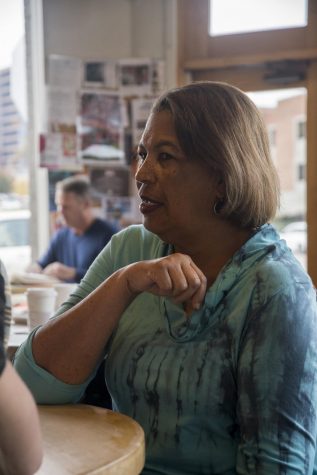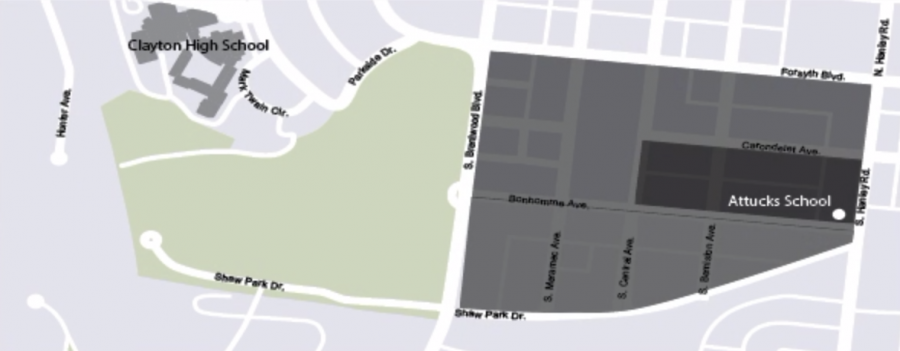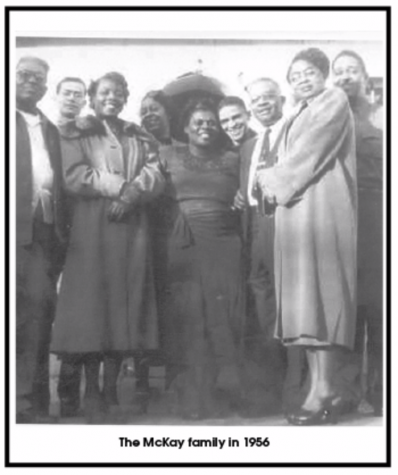Zoned Out
In the early 1940s, a young black man left his home in Mississippi to travel to St. Louis. Upon his arrival, he asked several acquaintances if they knew where the richest people in the city lived. Their answer was Clayton.
“[Anna Williams’ father] took the trolley to Clayton, got off at Bonhomme and Hanley, and there was a black crossing guard. And he said to the guy who’s helping these black kids across the street, ‘oh… you have black folks here? What’s the school system like?’ and the crossing guard told him it was great. He then wrote his wife, ‘get the kids together, here’s the money to come.’ And they lived in Clayton,” said former CHS history teacher Donna Rogers-Beard, who has spent the past several years researching the history of African Americans in Clayton.

Photo of former CHS history teacher Donna Rogers-Beard.
From the early 1880s to 1960, Clayton was home to a substantial percentage of black citizens (compared to today) — numbering nearly 300 black inhabitants at the height of the flourishing community. These people made up a predominantly African American neighborhood which was situated near the Ritz-Carlton off of Brentwood, Hanley and Bonhomme, as well as several surrounding streets. According to Rogers-Beard, it was a community where, despite the division elsewhere in the country, people of varying backgrounds and races felt comfortable.
“It was actually an integrated area. There were white people who lived in that area. And there were apartment houses, there were rooming houses, there were dwelling houses, it was a really mixed bag,” Rogers-Beard said.
The Bonhomme and Hanley neighborhood offered not only a relative sense of safety to those who lived there, but also an opportunity for black parents to seek a better education for their children. Crispus Attucks Elementary, erected in 1894 at the intersection of Bonhomme and Hanley roads, was a single-room school built in response to the segregation of Clayton schools, which were initially integrated.
“In comparison to the education that was afforded black people in the city at the time, the Attucks school was considered to be a good school. There were programs available during the summer that were paid for by Clayton’s board of education. And the people who went to Attucks school fondly remember those programs. It was a good place in the 1920s, ‘30s, ‘40s, ‘50s, when a lot of places were absolutely horrible. They had an opportunity to be in the best school district, which was Clayton, where property values were going up most,” Rogers-Beard said.
Bertha Rhoda, who taught at the Attucks school, told Wydown middle student interviewers in the 1970s that she did not believe that the children who attended her school felt estranged by their inability to attend white schools.
“We were just children and it was our school. Children do not see the things that adults see. There were children that were their white friends. They would play with them. There was no particular ill-feeling.”
Those who attended the Attucks school and lived in the neighborhood recall it fondly, accrediting the tight-knit community with their ability to experience a blissful and care-free childhood. In an interview with St. Louis Public Radio, former Clayton resident Reverend Doris Graham said, “Those were some of the best days of my life. I went to Attucks school from kindergarten to third grade.”

Other residents of the Bonhomme area shared similar sentiments. Cora Rue, a white woman who lived in Clayton for her entire life, said of her experiences in the neighborhood during an interview with Wydown Middle School students in the 1970s, “It was very peaceful. We did have a few negro families in Clayton who were fine people. There was no discrimination that I can remember.”
For 60 years, the neighborhood grew and thrived– according to Rogers-Beard, most people who lived there were related to each other by blood, marriage, or work. However, by the 1950s, city developers began to speculate that the Hanley and Bonhomme area would be relatively easy to expand into based on its demographics. At first, this proposition was met by resistance from Clayton officials who attempted to prevent a highway from being built through the Attucks school area, but eventually they agreed with the developers.
“They sat down, government leaders and business leaders, and they made a decision about how Clayton should be in 20 years. And they were doing that across the country in the 1950s. It was a time of economic prosperity and involved an incredible amount of change, a lot of movement of people. And I think when you are doing that you look at what’s the cheapest area to acquire through eminent domain, and also I think you look at who doesn’t have a seat at the table,” Rogers-Beard said. “So the decision was made to go down that strip and zone that from residential to commercial. First the city put in all sorts of requirements like you have to have so much footage, only so many people could be in these dwellings, etc. I don’t think anyone sat down and made a deliberate, ‘oh we’re gonna get rid of the black folks!’ as much as it was the cheapest area to gain access to.”
The rezoning was strategic in that African American families were individually offered above-market prices for their homes and forced out of the neighborhood slowly. Thus, Rogers-Beard said, the erasure of the community was not immediately apparent, even to those who continued to live there.
“It was done in a sort of buying off little by little until people realized that everyone was gone. You’d look around and say, ‘wait a minute … where’d everybody go?’” Rogers-Beard said. Essentially, the rezoning was completed in a fashion that was meant to avoid accusations of overt racism.
Gerard McKay, who attended the Attucks school in Clayton, as did his parents and seven older siblings, said, “First, the term ‘racist’ was not in our vocabulary or consciousness in Clayton in the mid-1950s.” Before having to move to California in 1957, his family had lived in Clayton since 1900, and possibly even earlier.

“Although I don’t recall any visible signage, there were clear and outward practices of segregation and discrimination by law and custom remaining in Clayton into my early childhood.”
McKay describes a pleasant childhood in Clayton, where he played outside, explored the city, and spent afternoons with his friends, both black and white.
“Although our family faced various degrees of segregation and discrimination over the years … Clayton was also in many ways an idyllic island.” In fact, McKay says that he didn’t really understand the concept of segregation until he left Attucks Elementary to attend the much larger Maryland School, where several teachers caused feelings of alienation and embarrassment due to his race. He remembers in particular his music teacher, who had the class sing songs of the antebellum south.
With added insight which he didn’t have as a young child, McKay says, the rezoning caused disruption, dislocation and ultimately, the total elimination of a community of people that had existed in Clayton since well before the turn of the 20th century … although rezoning created an overwhelming property tax burden, it also produced higher property values and higher selling prices. This again allowed families like ours, to have the financial ability to exercise new housing choices or to finance the start of a business as my father did.”
Although some citizens resisted the officials who hoped to push them out of Clayton, almost all of them were gone by 1960. The loss of African Americans in the Clayton area as a result of eminent domain was devastating. Culture, too, was lost in the rezoning — Clayton’s second-oldest church, which was a black church, was taken over and demolished, as well as the Attucks school.
“There used to be signs in [predominantly white areas of] Clayton that said ‘This is Clayton.’ Clayton saw itself as becoming a lot more uniform, a lot more affluent,” Rogers-Beard said.
Today, Clayton is still feeling the effects of its decision to displace so many black community members. Based on a survey by Data USA, there are currently 6.58 times more white people in Clayton than people of any other ethnic group. The Clayton School District, Rogers-Beard said, claims to prioritize diversity, while the city itself lacks citizens of diverse backgrounds.
“I don’t think that Clayton has been able to recover from losing that much diversity. Because we’ve been busing people in for I don’t know how long, but these people were a part of the community. They weren’t outsiders, they were tax-paying people who worked and lived in Clayton. It was a big, big mistake,” Rogers-Beard said.
Clayton’s Voluntary Student Transfer program began as the result of a court order that legally bound the state of Missouri to put into place a remedy for discriminatory schooling practices in the City of St. Louis. The program was designed to ensure equal learning opportunities for all children throughout St. Louis.
It buses in African American students from St. Louis neighborhoods across the city to schools in the Clayton School District The Voluntary Student Transfer program is paid for by the state of Missouri and is in the process of phasing out. The last year that new students will be enrolled is in 2023.
When she first heard of the School District of Clayton beginning a VST program, Rogers-Beard was against the idea. She viewed it as a cheaper solution to the very expensive problem of establishing affordable housing. After hearing of the accomplishments of students who benefitted from the program, however, her opinion on the matter shifted.
“Once the program began, I really saw so many success stories. But still there’s that feeling of being an outsider rather than being part of the community. Now that it’s ending, I think Clayton has another opportunity to say, ‘we want to make sure that we have diversity’. And maybe we need to revisit housing and income,” she said.
Superintendent of Clayton School District Sean Doherty said of VST, “We value the program because we want our students to have a window and mirror to the world. We want their school experience to be similar to what their life is going to be outside of the Clayton bubble. It’s an opportunity for our students to be exposed to diversity.”
Doherty also said that the members of Clayton’s school board, as well as himself, are currently brainstorming ways in which they could increase the school district’s diversity after VST comes to an end, as Clayton’s natural population of African Americans remains diminutive.
According to Sarah Umlauf, historian for the Clayton Century Foundation, one of the reasons that Clayton continues to lack affordable and diverse housing is that laws preventing minorities from purchasing houses may have existed during the early to mid 1900s.
“I’ve heard that there actually were rules against blacks owning homes in some of these neighborhoods. I believe that there were restrictions on African Americans building or buying homes [in Clayton],” Umlauf said.
The existence of such informal laws would not be surprising, as many neighborhoods throughout the United States enforced similar housing restrictions for several decades before the ratification of the Civil Rights Act in 1968, which made any form of viewed it as a cheaper solution to the very expensive problem of establishing affordable housing.
After hearing of the accomplishments of students who benefitted from the program, however, her opinion on the matter shifted.
“Once the program began, I really saw so many success stories. But still there’s that feeling of being an outsider rather than being part of the community. Now that it’s ending, I think Clayton has another opportunity to say, ‘we want to make sure that we have diversity’. And maybe we need to revisit housing and income,” she said.
Superintendent of Clayton School District Sean Doherty said of VST, “We value the program because we want our students to have a window and mirror to the world. We want their school experience to be similar to what their life is going to be outside of the Clayton bubble. It’s an opportunity for our students to be exposed to diversity.”
Forces beyond the rules of small neighborhoods also played a role in making Clayton such a white-dominated city.
In 1934 the federal government established the Federal Housing Administration (FHA). This organization was created to insure home mortgages in the United States so that banks could loan money without risking losing money.
The FHA used maps created by the Homeowners Loan Association to determine what mortgages to insure. These maps were color-coded according to which houses and neighborhoods would be most beneficial to invest in (“low risk” investments, which were green) as opposed to housing that would be least beneficial to invest in (“high risk” investments, which were red).
Older housing, multi-family housing and housing in predominantly African American neighborhoods were all considered “high-risk”.
By these calculations, the FHA decided that banks shouldn’t loan property to people in those areas.
“[These areas] were essentially starved of investment capital,” said Margaret Garb, professor at Washington University.
The capital that was not given to African American families was instead directed towards segregated and primarily white suburbs.
Another major factor was that of real-estate steering. This occurs when realtors and developers tend to steer white families to predominantly white neighborhoods and black families to predominantly black neighborhoods.
According to Garb, this process is carried out under the belief that it will create better housing markets; however, whether or not this is the case is unclear.
Although lack of investment capital and real-estate steering played a large part in the ultimate segregation of St. Louis, black citizens were often refused the opportunity to live in affluent neighborhoods simply because white families did not want to live next to them.
“Most suburbs simply refused to sell houses to African Americans. Even if a black family could get a loan, developers refused to sell to them on the basis that white families didn’t want to live next to black families. This is a combination of both private developers and federal housing and banking programs to create a highly segregated housing market,” Garb said.
The policies that were put into place across the United States to enforce segregation through housing have had permanent effects on its demography, especially in St. Louis.
“St. Louis is certainly considered one of the most segregated cities in America. There were long-term institutional forces creating segregation in St. Louis city, this was not based just on personal choice,” Garb said.
When asked what St. Louis and specifically Clayton could do to become more integrated, Rogers-Beard again emphasized the importance of accessible housing.
Additionally, she stressed the fact that there is a lack of representation of African Americans in the local government, and that this stunts Clayton’s ability to move towards a more integrated population.
“[Black people] have to have a seat at the table,” Rogers-Beard said.
Rogers-Beard contended that when one race holds the majority of political influence, they are able to silence those who have opinions with which they do not agree, and erase people with whom they do not want to interact.
She defined power as, “the ability to remove what you don’t like,” which was an ability that white developers and government officials had when they decided to rezone African Americans in the Bonhomme and Hanley neighborhood.
Addressing this fact, Rogers-Beard said, “The irony was, so few people knew that there were black people in Clayton … even people living in Clayton. It’s that whole idea of invisible Clayton, it’s this population that people just ignored. And there were a lot of them. That they existed at all, is, I think, significant for them. And that’s what’s important. That it was significant to them.”
